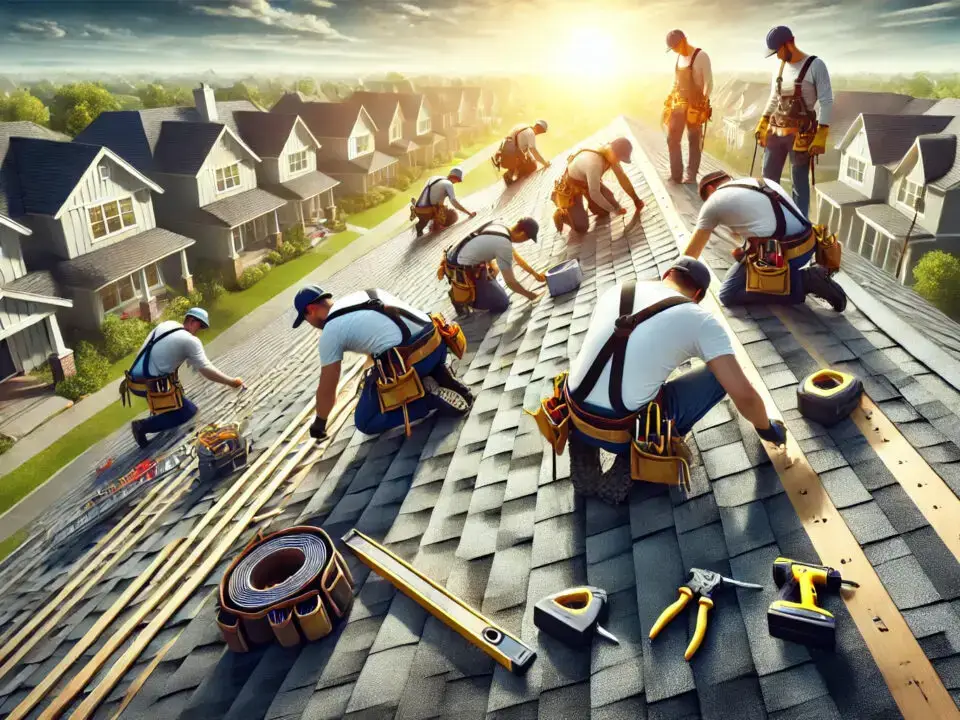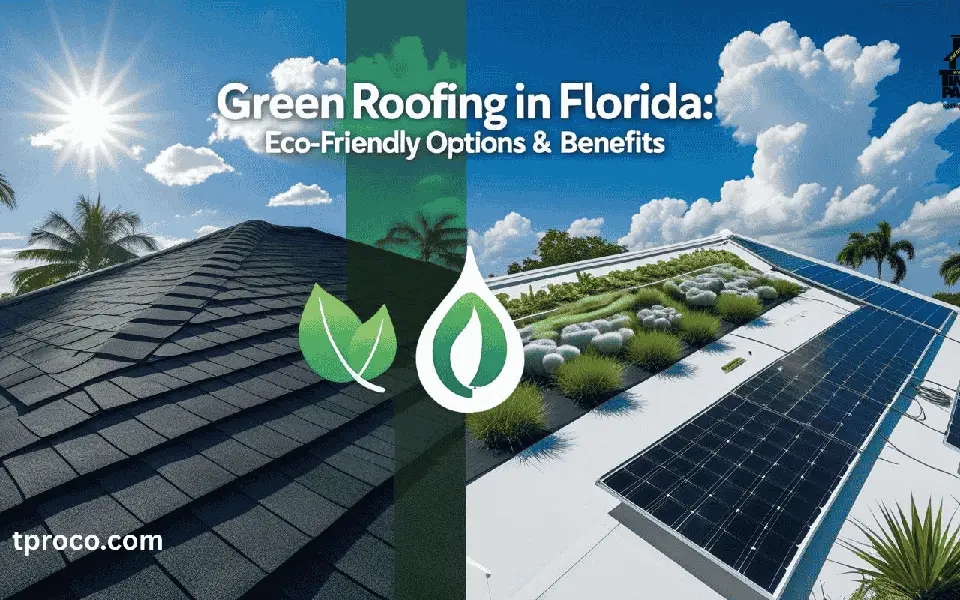Our Blogs
The Complete Guide to Roof Leak Repairs: Causes, Fixes, and Costs
Welcome to The Complete Guide to Roof Leak Repairs: Causes, Fixes, and Costs. This comprehensive guide aims to equip you with the knowledge needed to address roof leaks effectively. We delve into:
- Common causes of roof leaks like improper installation, aging roofs, debris accumulation, and storm damage.
- Signs of a roof leak such as water stains, mold growth, and damaged shingles.
- Repair strategies, including DIY fixes and professional solutions.
- Detailed cost breakdowns for various repair scenarios.
Addressing roof leaks promptly is crucial. Ignoring them can lead to severe structural damage and costly repairs. Understanding the root causes and associated costs helps you make informed decisions about maintenance and repairs, ensuring your home remains safe and secure.
For residents in Winter Garden or Pine Hills, TPROCO offers top-notch roofing services that can assist with these urgent repairs. They also provide expert assistance for insurance claims related to emergency situations, which can be invaluable in navigating the complexities of insurance after a roof-related incident.
Feel free to navigate through each section as we explore expert strategies for effective roof repair. If you're in need of immediate assistance or a thorough home inspection to assess the extent of the damage, remember that professional help is just a call away.
Understanding Roof Leaks
How Roof Leaks Occur
Roof leaks can stem from a variety of issues, and recognizing these causes is crucial for effective prevention and repair. Common causes of roof leaks include:
- Improper Installation: Misaligned shingles, inadequate sealing, and incorrect flashing installation can lead to early failures in the roofing system.
- Aging Roofs: Over time, exposure to weather elements and temperature fluctuations deteriorates roofing materials. Aging roofs are more susceptible to cracking, splitting, and losing their protective granules.
- Debris Accumulation: Leaves, branches, and other debris can trap moisture on the roof surface. This accumulation often leads to decay and clogged gutters, which cause water pooling and eventual leaks.
- Storm Damage: Severe weather conditions such as wind, rain, or hail can cause immediate damage. High winds may lift shingles, while hail can create punctures or bruises in the roofing material. It's essential to understand how to prepare your roof for hurricane season in order to minimize such storm damage.
Identifying Signs of a Roof Leak
Early detection of roof leaks can prevent extensive damage. Key signs to look for include:
- Water Stains: Brown or yellow stains on ceilings or walls indicate water penetration from above. These stains are often irregular in shape and may expand over time.
- Mold Growth: Persistent moisture creates an ideal environment for mold. Mold growth can appear as dark spots on ceilings or walls and is often accompanied by a musty odor.
- Damaged Shingles: Missing, cracked, or curling shingles are direct indicators of potential leak points. Inspecting the roof visually from the ground or using binoculars can spot these issues.
- Visible Drips: During rainfall, visible drips inside the home signify an active leak. These drips might be found near windows, chimneys, or skylights.
Understanding these causes and signs equips homeowners with the knowledge needed for timely intervention. Proactive measures not only mitigate damage but also extend the life of the roofing system.
For those considering remodeling their homes or exploring different roofing options tailored for Florida's unique climate, it's worth looking into the types of roofs suitable for Florida businesses and homes. Additionally, if you're located in areas like Clermont or Orlando and require professional roofing services, companies like TPROCO offer top-notch roofing services in Clermont and Orlando, respectively.

Repairing Roof Leaks
Steps to Repair a Roof Leak
1. Conduct an Inspection
- Locate the Source: Begin by identifying the exact location of the leak, which can often be tricky. Start from the inside where water stains are visible and trace upwards.
- Examine Roof Surface: Carefully inspect shingles, flashing, vents, and other roof components for signs of damage or wear.
If you're in need of professional assistance during this inspection phase, consider reaching out to a roofing company in Chuluota that specializes in such services.
2. Make Prompt Repairs
- Replace Damaged Shingles: Remove any broken or curled shingles and replace them with new ones.
- Seal Cracks and Holes: Use roofing cement or sealant to fill in any cracks or holes, particularly around flashing and joints.
- Clean Gutters and Downspouts: Ensure gutters are free of debris to prevent water buildup which can exacerbate leaks.
3. Use High-Quality Materials
- Roofing Cement and Sealants: Opt for premium-grade materials that provide durable sealing.
- Replacement Shingles: Choose high-quality shingles that match your existing roof’s material and color for uniformity.
DIY vs. Professional Repairs
DIY Repairs
Pros:
- Cost-Effective: Save on labor costs by doing the repair yourself.
- Immediate Action: Address minor leaks quickly without waiting for a contractor.
Cons:
- Limited Expertise: Lack of professional knowledge might lead to incomplete or incorrect repairs.
- Safety Risks: Working on a roof involves significant risk, especially without proper equipment.
Professional Roofing Contractor
For those considering professional help, it's essential to select a reputable roofing contractor. For instance, if you're located in Winter Garden or Windermere, Timothy Parks roofing & Construction Inc. offers quality roofing services in Winter Garden and Windermere, ensuring expert handling of your roofing problems.
Pros:
- Expertise and Experience: Professionals have the skills to accurately diagnose and repair leaks.
- Quality Assurance: Use of high-quality materials and adherence to industry standards ensures long-lasting repairs.
Cons:
- Higher Costs: Professional services come with higher fees due to labor and expertise involved.
By understanding the steps involved in repairing a roof leak and weighing the pros and cons of DIY versus professional repairs, homeowners can make informed decisions. Whether opting for a quick fix or seeking expert assistance from trusted providers like TPROCO's citizen inspection services in Central Florida, addressing roof leaks promptly is crucial for maintaining the integrity of your home. This comprehensive understanding helps ensure effective repair strategies are employed while highlighting essential considerations in maintaining your roof's health.
Costs Associated with Roof Leak Repairs
Understanding the financial aspect of roof leak repairs is essential for planning and budgeting. Here's a detailed breakdown of the average repair costs for different types of roof leak issues.
Average Repair Costs
Roof leak repairs can vary significantly depending on the severity and complexity of the problem:
- Minor Repairs: $150 to $1,000
- Moderate Repairs: $1,000 to $3,000
- Major Repairs: Over $6,000
Several factors influence these costs, including the type of roof (flat vs. pitched), materials used (asphalt shingles vs. metal), labor charges, and accessibility of the damaged area.
Common Repair Cost Estimates
Specific scenarios often encountered in roof leakage repair include:
- Cracked Pipe Boot: Typically ranges from $250 to $600. The pipe boot seals around plumbing vents and is crucial for preventing leaks.
- Metal Gas Vent Collar Failure: Repairing this can cost between $400 and $1,500. Metal gas vent collars deteriorate with time and weather exposure, leading to potential leaks.
- Leaking Valleys: Costs range from $300 to $1,500. Valleys are where two sections of the roof meet and are prone to leaking due to improper sealing or aging materials.
- Skylight Leaks: These repairs usually fall between $225 and $800. Skylights can be a common source of leaks due to faulty installation or worn-out seals.
Labor charges often comprise 60% or more of the total cost. Additionally, material quality plays a significant role; using high-quality roofing materials ensures durability but at a higher initial cost.
Regular inspections and maintenance can mitigate these expenses by catching issues early before they escalate into major problems. Whether you choose to DIY or hire a professional contractor, being informed about potential costs helps in making sound decisions for your roof's longevity.
If you're located in areas like Oviedo, Winter Springs, Maitland, or Casselberry in Florida, it's advisable to consult with local experts such as those from TPROCO who offer comprehensive roofing services including repairs and replacements tailored to your specific needs.
Preventive Measures and Maintenance Tips
Preventing roof leaks requires a proactive approach. Regular maintenance is crucial to ensure your roof remains in top condition and can withstand harsh weather conditions. This is where property maintenance services come into play, helping to keep your property in optimal shape throughout the year.
Regular Inspections
- Semi-Annual Roof Inspections: Conduct inspections at least twice a year, preferably in spring and fall. Look for signs of wear and tear, such as cracked or missing shingles, loose flashing, and clogged gutters.
- Post-Storm Checks: After heavy rain or storms, check for any immediate damage that could lead to leaks. Pay attention to areas around chimneys, skylights, and vents.
Debris Removal
- Gutter Cleaning: Clean gutters regularly to prevent water pooling, which can cause leaks. Ensure downspouts are clear to allow proper water flow.
- Roof Surface Cleaning: Remove leaves, branches, and other debris from the roof surface to prevent moisture retention that can deteriorate roofing materials.
Best Practices for Fixing Leaks
Fixing a leak promptly with the right materials ensures lasting results:
- High-Quality Sealants: Use roof leak repair sealant specifically designed for roofing applications. It provides a durable barrier against water infiltration.
- Proper Flashing Installation: Ensure flashing around chimneys, vents, and skylights is correctly installed and sealed to prevent leaks in these vulnerable areas.
Emergency Roof Leak Repairs
When facing an emergency roof leak during heavy rain:
- Temporary Fixes: Use tarps or plastic sheeting to cover the affected area until professional help arrives. Secure it tightly to prevent wind from displacing it.
- Quick Patch Kits: Keep an emergency roof patch kit handy for small repairs. These kits often include adhesive patches that provide a quick fix until permanent repairs can be made.
Regular maintenance practices not only help in preventing roof leaks but also extend the life of your roof. Promptly addressing minor issues before they escalate into major problems can save time and money in the long run.
If you're considering hiring a professional, TPROCO offers excellent roofing services including repairs, replacements, and inspections in areas like Altamonte Springs Roofing Contractor Altamonte Springs Fl, St. Cloud Roofing Contractor St. Cloud, FL, and Apopka Roofing company Apopka, FL.
Conclusion
Taking proactive measures against roof leaks is vital for maintaining the longevity of your home. Regular inspections, timely repairs, and using high-quality materials can prevent costly damages. Remember, addressing even minor issues promptly can save time and money in the long run. Consult professional roofing contractors for complex problems to ensure effective solutions.
For more information on roof leak repairs, revisit The Complete Guide to Roof Leak Repairs: Causes, Fixes, and Costs. Additionally, considering the implementation of SWR roofing could provide superior protection for your home in Florida. If you're looking for alternative construction solutions such as pole barn homes, consulting with experts can yield high-quality, cost-effective results tailored to your needs. Stay informed, stay prepared, and protect your home from future leaks.



